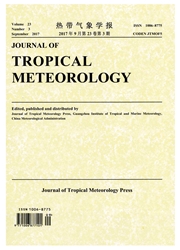

 中文摘要:
中文摘要:
Assimilating satellite radiances into Numerical Weather Prediction(NWP) models has become an important approach to increase the accuracy of numerical weather forecasting. In this study, the assimilation technique scheme was employed in NOAA’s STMAS(Space-Time Multiscale Analysis System) to assimilate AMSU-A radiances data.Channel selection sensitivity experiments were conducted on assimilated satellite data in the first place. Then, real case analysis of AMSU-A data assimilation was performed. The analysis results showed that, following assimilating of AMSU-A channels 5-11 in STMAS, the objective function quickly converged, and the channel vertical response was consistent with the AMSU-A weighting function distribution, which suggests that the channels can be used in the assimilation of satellite data in STMAS. With the case of the Typhoon Morakot in Taiwan Island in August 2009 as an example, experiments on assimilated and unassimilated AMSU-A radiances data were designed to analyze the impact of the assimilation of satellite data on STMAS. The results demonstrated that assimilation of AMSU-A data provided more accurate prediction of the precipitation region and intensity, and especially, it improved the 0-6h precipitation forecast significantly.
 英文摘要:
英文摘要:
Assimilating satellite radiances into Numerical Weather Prediction(NWP) models has become an important approach to increase the accuracy of numerical weather forecasting. In this study, the assimilation technique scheme was employed in NOAA's STMAS(Space-Time Multiscale Analysis System) to assimilate AMSU-A radiances data.Channel selection sensitivity experiments were conducted on assimilated satellite data in the first place. Then, real case analysis of AMSU-A data assimilation was performed. The analysis results showed that, following assimilating of AMSU-A channels 5-11 in STMAS, the objective function quickly converged, and the channel vertical response was consistent with the AMSU-A weighting function distribution, which suggests that the channels can be used in the assimilation of satellite data in STMAS. With the case of the Typhoon Morakot in Taiwan Island in August 2009 as an example, experiments on assimilated and unassimilated AMSU-A radiances data were designed to analyze the impact of the assimilation of satellite data on STMAS. The results demonstrated that assimilation of AMSU-A data provided more accurate prediction of the precipitation region and intensity, and especially, it improved the 0-6h precipitation forecast significantly.
 同期刊论文项目
同期刊论文项目
 同项目期刊论文
同项目期刊论文
 期刊信息
期刊信息
